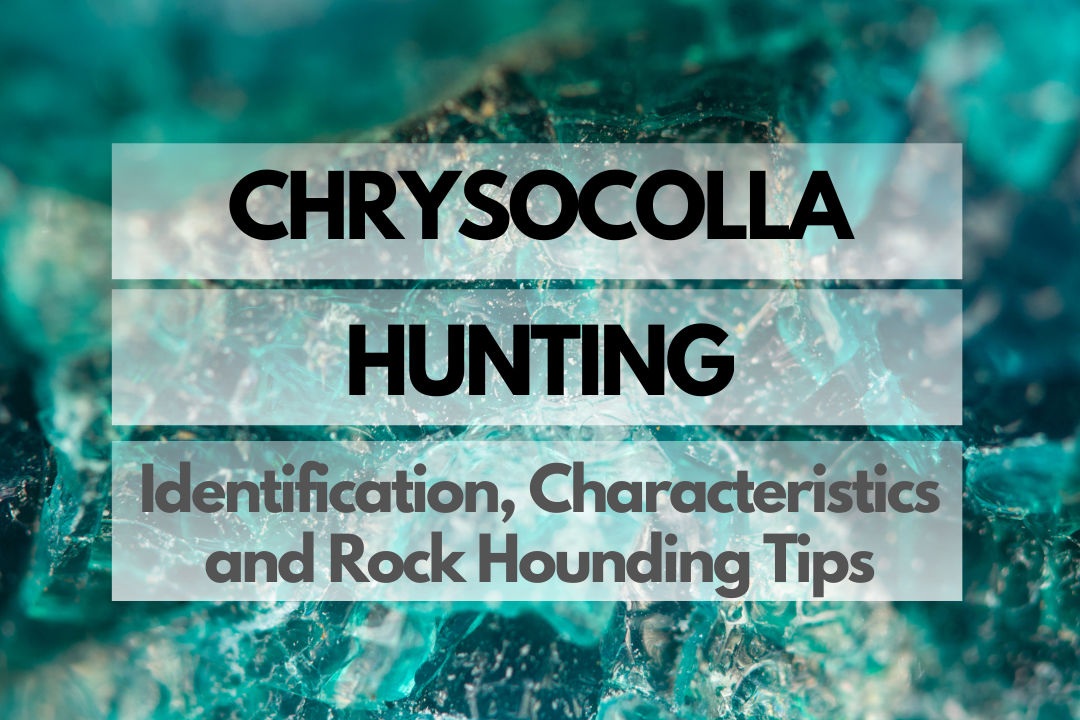Step into the captivating world of chrysocolla rock hounding, where you’ll discover this vibrant and beautiful gemstone with striking shades of blue and green. In this article, we’ll dive into the history and origin of chrysocolla, its identification and physical properties, different types, uses, and its worth. Get ready to embark on an exhilarating journey filled with fun and knowledge!
History & Origin of Chrysocolla
Chrysocolla is a copper-based mineral that has been known and used by various civilizations for thousands of years. The name “chrysocolla” comes from the Ancient Greek words “chrysos,” meaning gold, and “kolla,” meaning glue, as it was used as a soldering agent for gold by the ancient Greeks. The beauty of chrysocolla has been appreciated by many cultures, including the ancient Egyptians, who used it for decorative purposes and believed it had protective powers. Today, chrysocolla continues to captivate people worldwide with its vibrant colors and unique properties.
Chrysocolla Identification & Physical Properties
Get to know the key physical properties of chrysocolla with this helpful table:
| Property | Description |
|---|---|
| Chemical Formula | Cu2H2Si2O5(OH)4·nH2O |
| Crystal System | Orthorhombic |
| Luster | Vitreous to dull |
| Transparency | Translucent to opaque |
| Streak | White to pale blue |
Chrysocolla Colors
Chrysocolla displays a stunning range of colors, from vibrant blues and greens to more subdued shades. Its colors result from the presence of copper in its composition, with more copper content leading to deeper and richer hues. Common colors include turquoise, teal, sky blue, and various shades of green.
Chrysocolla Hardness
The hardness of chrysocolla varies significantly, typically ranging from 2 to 4 on the Mohs scale. This variability is due to the presence of other minerals, such as quartz or chalcedony, which can affect its overall hardness. While it’s a relatively soft mineral, chrysocolla can still be used in jewelry and other decorative items when stabilized or combined with harder materials.
Chrysocolla Types
Gem Silica Chrysocolla
Gem silica chrysocolla is a rare and highly sought-after variety that displays a rich, translucent blue or green color. This type of chrysocolla is often found in the presence of quartz or chalcedony, which contributes to its increased hardness and durability. Gem silica chrysocolla is prized for its beauty and is often used in high-quality jewelry.
Chrysocolla-Malachite
Chrysocolla-malachite is a combination of chrysocolla and malachite, another copper-based mineral. This mixture results in a striking blend of blue and green hues, with unique patterns and banding. Chrysocolla-malachite is often used for decorative items, such as carvings and sculptures, as well as in jewelry designs.
Chrysocolla-Chalcedony
Chrysocolla-chalcedony is a mixture of chrysocolla and chalcedony, a microcrystalline form of quartz. This combination results in a more durable and harder material, with a beautiful mix of blue and green colors. Chrysocolla-chalcedony is often used in jewelry and other decorative items, where its increased hardness is an advantage.
Chrysocolla Uses
Chrysocolla has a variety of uses, including:
- Jewelry – such as pendants, earrings, rings, and bracelets
- Decorative items – like carvings, sculptures, and ornamental pieces
- Healing and metaphysical purposes – believed to promote tranquility, communication, and emotional healing
- Historical use – as a soldering agent for gold in ancient civilizations
How Much Is Chrysocolla Worth?
The value of chrysocolla depends on factors such as color, quality, size, and the presence of other minerals. In general, high-quality gem silica chrysocolla with vivid colors and translucency can fetch prices between $50 and $100 per carat. Lower-quality material or chrysocolla mixed with other minerals, like malachite or chalcedony, may be priced between $5 and $50 per carat. The value of individual pieces may vary based on factors such as craftsmanship, design, and overall aesthetic appeal.
Chrysocolla Rock Hounding Tips
Ready to embark on an exciting chrysocolla hunting adventure? Let’s explore some tips and tricks that will help you make the most of your rock hounding experience, from essential tools and equipment to safety tips and the best places to find chrysocolla.
Essential Tools and Equipment
Equipping yourself with the right tools and equipment is crucial for successful chrysocolla hunting. Here’s a list of items to consider:
- Rock hammer or geologist’s hammer – for breaking and splitting rocks
- Chisel – for extracting chrysocolla from the host rock
- Hand lens or magnifying glass – for close examination of specimens
- Field notebook and pen – for documenting your discoveries
- Sturdy gloves – for hand protection
- Backpack or container – for carrying your finds
- GPS or map – for navigation and marking locations
Safety Tips
Rock hounding can be a fun and rewarding hobby, but it’s essential to prioritize safety during your adventures. Keep these tips in mind:
- Always wear proper safety gear, such as gloves, eye protection, and sturdy boots with ankle support
- Be cautious of your surroundings, especially when working near cliffs, steep slopes, or water
- Stay hydrated and carry sufficient food and water
- Inform someone of your plans and expected return time
- Be aware of local wildlife and take necessary precautions
- Follow local regulations and respect private property
Chrysocolla Hunting: Where to Find Chrysocolla
Chrysocolla can be found in various locations worldwide, particularly in areas with significant copper deposits. Some of the best places to find chrysocolla include the southwestern United States, Mexico, Chile, and the Democratic Republic of Congo. Below is a table detailing specific sites and their locations:
| Site/Area | Location |
|---|---|
| Morenci Mine | Arizona, USA |
| Bisbee | Arizona, USA |
| Ray Mine | Arizona, USA |
| Cananea | Sonora, Mexico |
| Atacama Desert | Chile |
| Lubumbashi | Democratic Republic of Congo |
Caring For Your Chrysocolla
To preserve the beauty and quality of your chrysocolla specimens, follow these care tips:
- Store chrysocolla in a cool, dry place away from direct sunlight
- Keep chrysocolla separate from harder minerals to prevent scratches
- Clean chrysocolla gently with a soft brush and soapy water, then rinse thoroughly and pat dry
- Avoid using harsh chemicals or ultrasonic cleaners
Additional Resources
Expand your knowledge and connect with fellow rock hounds with these helpful resources:
- US Geological Survey (USGS) – https://www.usgs.gov/
- Mindat.org – https://www.mindat.org/
- Rock Tumbling Hobby forum – https://andy321.proboards.com/
- The Rockhound’s Handbook by James R. Mitchell
Additional Chrysocolla FAQs
What are the benefits of Chrysocolla?
Chrysocolla is a beautiful and unique mineral that can be used for jewelrymaking, lapidary arts, and as a decorative piece for collectors. Its vibrant blue-green color and intricate patterns make it a highly sought-after gemstone. Additionally, chrysocolla is believed to have various metaphysical properties (see below).
Do Chrysocolla have any healing properties?
While there is no scientific evidence to support the healing properties of chrysocolla, many people believe that it can help with communication, emotional balance, and inner strength. It is also said to have a calming effect, helping to ease anxiety and stress.
Do Chrysocolla have any spiritual meaning?
In crystal healing and metaphysical practices, chrysocolla is associated with the throat and heart chakras. It is believed to aid in communication, self-expression, and emotional healing. Chrysocolla is also said to promote inner wisdom, intuition, and spiritual growth.
Do I need a permit to go Chrysocolla hunting?
Permit requirements for rock hounding vary depending on the location and land ownership. In the United States, collecting on public lands managed by the Bureau of Land Management (BLM) or the US Forest Service typically requires a permit. For more information, visit the BLM website at https://www.blm.gov/ and the US Forest Service website at https://www.fs.usda.gov/. Always check local regulations and obtain necessary permissions before hunting for chrysocolla.
Closing Thoughts
Chrysocolla hunting can be a thrilling and rewarding experience for rock hounds of all skill levels. With the right tools, safety precautions, and knowledge of where to find this captivating mineral, you’re well on your way to a successful chrysocolla adventure. So go ahead and start planning your next rock hounding trip who knows what treasures await you!

